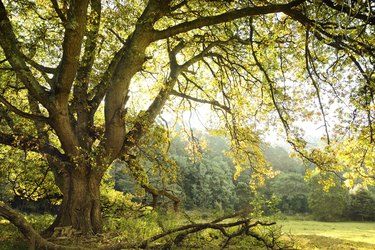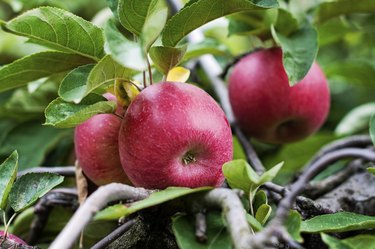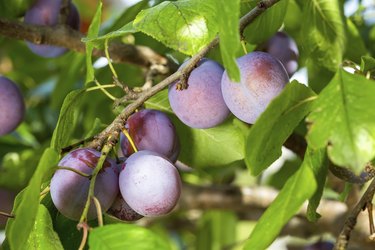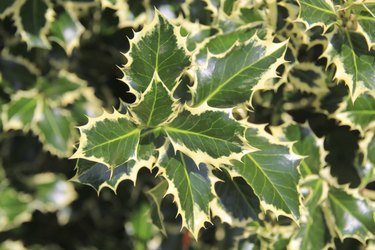
Hardwoods are hard because their structure tends to be denser than softwoods. In general, hardwoods have more wood cells and less air per square inch than softwoods. Some softwoods, however, can be very hard; pine, for example. Conversely, some hardwoods, such as balsa, are quite soft. The ultimate distinction between hardwood and softwood trees is not based on physical hardness but on botanical classification. Hardwoods are members of the angiosperm taxonomic class, while softwoods are gymnosperms.
Seeds and Leaves
Video of the Day

In hardwoods, which are angiosperms, the ovule, or seed, is enclosed in an ovary. Think, for example, of an apple. The seeds of the apple are enclosed inside the flesh of the apple. That characteristic makes an apple tree (Malus spp.) a hardwood. By contrast, softwoods are gymnosperms. Their seeds are not enclosed in an ovule. A pine tree (Pinus spp.), for example, has bare seeds tucked into the cone, making it a gymnosperm and thus a softwood. Softwoods tend to have needles and are usually evergreen, as opposed to hardwoods, which tend to have broad leaves and be deciduous.
Video of the Day
Shade Trees

Hardwoods make good shade trees. Among the most common hardwood shade trees are ash (Fraxinus spp.), oak (Quercus spp.), maple (Acer spp.), box elder (Acer negundo), locust (Robinia spp.), birch (Betula spp.), elm (Ulmus spp.) and beech (Fagus spp.). The leaves on these hardwood trees tend to be broad. In the autumn they usually change color and drop. Because these hardwoods have dense trunks, they make better fireplace wood than softwoods. A cord of wood from a hardwood shade tree will contain more woody fibers than a cord of wood from a softwood conifer. More woody fibers means the cord will burn longer.
Fruit and Nut Trees

Fruit and nut trees are also hardwoods. Apples (Malus spp., USDA zones 4-8), peaches (Prunus persica, zones 5-9), plums (Prunus domestica spp., zones 4-9), cherries (Prunus avium, spp., zones 3-8), mulberries (Morus spp., zones 4-9) and pears (Pyrus communis, zones 4-9) all have their seeds enclosed inside fruit. That characteristic makes them angiosperms and hardwoods. Similarly, nut trees such as hickory (Carya ovata, zones 5-8a), almond (Prunus dulcis, zones 5-8), pecan (Carya illinoinensis, zones 5-9) and walnut (Juglans regia, zones 5-7) are also hardwoods. In the case of nuts, the nut is the seed of the tree. In some nuts, cashews for example, the nut is surrounded by a fruit. In others, walnuts and pecans to name two, the nut is surrounded by a shell. In both cases, the seed is not bare. That makes the tree an angiosperm, or hardwood.
Shrubs Can Be Hardwoods

Though we think of hardwoods as being trees, not all hardwoods are full-size trees. Some are shrubs or bushes. They are still hardwoods because they are angiosperms, and they have woody trunks containing hard wood. Serviceberry trees (Amelanchier spp., with varieties native to the entire U.S.) are large shrublike hardwoods. Holly (Ilex spp., zones 5-9) are angiosperms and therefore hardwoods despite the fact that they are evergreen and some are almost vinelike. Creosote bushes (Larrea tridentata, zones 8-10, arid regions only) are angiosperms. Their wood is so dense that it sinks in water.
- University of Tennessee: Hardwoods and Softwoods
- The Forestry OutReach Site: Angiosperm or Gymnosperm?
- Encyclopedia Britannica: Ovule
- Cofrin Center for Biodiversity: Trees of Wisconsin
- Plant Information Center: North Carolina Angiosperm Trees by Common Name
- USDA Plants Database: Amelanchier Medik.
- Firewood.com: Frequently Asked Questions
- Wayne's Word: Hardwoods
- Virginia Tech: Creosote Bush
- Virginia Tech Dendrology Factsheets: Angiosperm Families